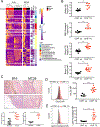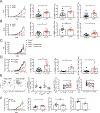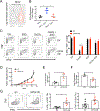Uptake of oxidized lipids by the scavenger receptor CD36 promotes lipid peroxidation and dysfunction in CD8+ T cells in tumors
- PMID: 34102100
- PMCID: PMC9273026
- DOI: 10.1016/j.immuni.2021.05.003
Uptake of oxidized lipids by the scavenger receptor CD36 promotes lipid peroxidation and dysfunction in CD8+ T cells in tumors
Abstract
A common metabolic alteration in the tumor microenvironment (TME) is lipid accumulation, a feature associated with immune dysfunction. Here, we examined how CD8+ tumor infiltrating lymphocytes (TILs) respond to lipids within the TME. We found elevated concentrations of several classes of lipids in the TME and accumulation of these in CD8+ TILs. Lipid accumulation was associated with increased expression of CD36, a scavenger receptor for oxidized lipids, on CD8+ TILs, which also correlated with progressive T cell dysfunction. Cd36-/- T cells retained effector functions in the TME, as compared to WT counterparts. Mechanistically, CD36 promoted uptake of oxidized low-density lipoproteins (OxLDL) into T cells, and this induced lipid peroxidation and downstream activation of p38 kinase. Inhibition of p38 restored effector T cell functions in vitro, and resolution of lipid peroxidation by overexpression of glutathione peroxidase 4 restored functionalities in CD8+ TILs in vivo. Thus, an oxidized lipid-CD36 axis promotes intratumoral CD8+ T cell dysfunction and serves as a therapeutic avenue for immunotherapies.
Keywords: CD36; CD8(+) T cells; lipid peroxidation; oxidized lipids; tumor microenvironment.
Copyright © 2021 Elsevier Inc. All rights reserved.
Conflict of interest statement
Declaration of interests G.C. receives research funding from Bayer AG and Boehringer Ingelheim, but the funding is not relevant to the current study. J.L.W. and X.S. are named inventors on patent applications or patents related to the use of oxidation-specific antibodies held by UCSD. R.Z. is an inventor on patent applications related to work on GITR, PD-1, and CTLA-4. R.Z. is a consultant for Leap Therapeutics and iTEOS. T.M. is a cofounder and holds equity in IMVAQ Therapeutics. T.M. is a consultant for Immunos Therapeutics, Pfizer, and Immunogenesis. T.M. has research support from Bristol-Myers Squibb; Surface Oncology; Kyn Therapeutics; Infinity Pharmaceuticals, Inc.; Peregrine Pharmaceuticals, Inc.; Adaptive Biotechnologies; Leap Therapeutics, Inc.; and Aprea. T.M. has patents on applications related to work on oncolytic viral therapy, alpha virus-based vaccines, neoantigen modeling, CD40, GITR, OX40, PD-1, and CTLA-4. J.D.W. is a consultant for Adaptive Biotech, Amgen, Apricity, Ascentage Pharma, Astellas, AstraZeneca, Bayer, Beigene, Boehringer Ingelheim, Bristol Myers Squibb, Celgene, Chugai, Elucida, Eli Lilly, F Star, Georgiamune, Imvaq, Kyowa Hakko Kirin, Linneaus, Merck Pharmaceuticals, Neon Therapeutics, Polynoma, Psioxus, Recepta, Takara Bio, Trieza, Truvax, Sellas Life Sciences, Serametrix, Surface Oncology, Syndax, Syntalogic, and Werewolf Therapeutics. J.D.W. reports grants from Bristol Myers Squibb and Sephora. J.D.W. has equity in Tizona Pharmaceuticals, Adaptive Biotechnologies, Imvaq, Beigene, Linneaus, Apricity, Arsenal IO, and Georgiamune. J.D.W. is an inventor on patent applications related to work on DNA vaccines in companion animals with cancer, assays for suppressive myeloid cells in blood, oncolytic viral therapy, alphavirus-based vaccines, neo-antigen modeling, CD40, GITR, OX40, PD-1, and CTLA-4.
Figures







Comment in
-
CD36 pumps fat to defang killer T cells in tumors.Cell Metab. 2021 Aug 3;33(8):1509-1511. doi: 10.1016/j.cmet.2021.07.004. Cell Metab. 2021. PMID: 34348095
-
Bad Cholesterol Uptake by CD36 in T-Cells Cripples Anti-Tumor Immune Response.Immunometabolism. 2021;3(4):e210028. doi: 10.20900/immunometab20210028. Epub 2021 Sep 14. Immunometabolism. 2021. PMID: 34603769 Free PMC article.
References
-
- Abumrad N, Harmon C, and Ibrahimi A. (1998). Membrane transport of long-chain fatty acids: evidence for a facilitated process. Journal of lipid research 39, 2309–2318. - PubMed
-
- Alfei F, Kanev K, Hofmann M, Wu M, Ghoneim HE, Roelli P, Utzschneider DT, von Hoesslin M, Cullen JG, Fan Y, et al. (2019). TOX reinforces the phenotype and longevity of exhausted T cells in chronic viral infection. Nature 571, 265–269. - PubMed
-
- Bligh EG, and Dyer WJ. (1959). A rapid method of total lipid extraction and purification. Can J Biochem Physiol 37, 911–917. - PubMed
Publication types
MeSH terms
Substances
Grants and funding
- S10 OD021815/OD/NIH HHS/United States
- R01 HL105278/HL/NHLBI NIH HHS/United States
- R01 CA206483/CA/NCI NIH HHS/United States
- P42 ES010337/ES/NIEHS NIH HHS/United States
- P30 CA030199/CA/NCI NIH HHS/United States
- R00 HL148504/HL/NHLBI NIH HHS/United States
- RF1 AG064049/AG/NIA NIH HHS/United States
- P30 CA023100/CA/NCI NIH HHS/United States
- R37 DK057978/DK/NIDDK NIH HHS/United States
- R01 CA240909/CA/NCI NIH HHS/United States
- P30 DK056341/DK/NIDDK NIH HHS/United States
- R01 DK120480/DK/NIDDK NIH HHS/United States
- K99 HL148504/HL/NHLBI NIH HHS/United States
- R01 HL148188/HL/NHLBI NIH HHS/United States
- R01 DK057978/DK/NIDDK NIH HHS/United States
- R01 GM102491/GM/NIGMS NIH HHS/United States
- P30 CA014195/CA/NCI NIH HHS/United States
LinkOut - more resources
Full Text Sources
Other Literature Sources
Medical
Molecular Biology Databases
Research Materials

